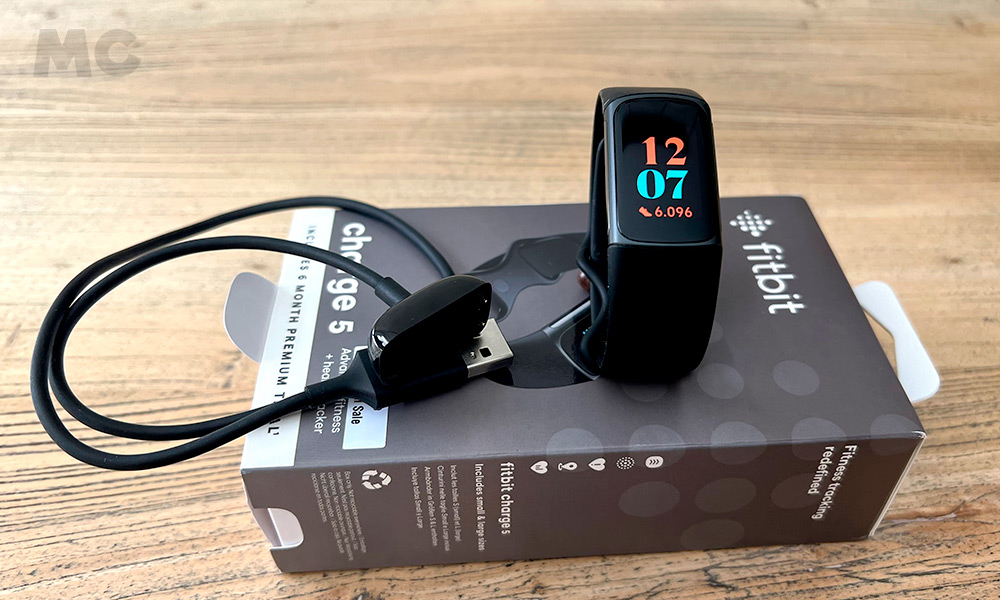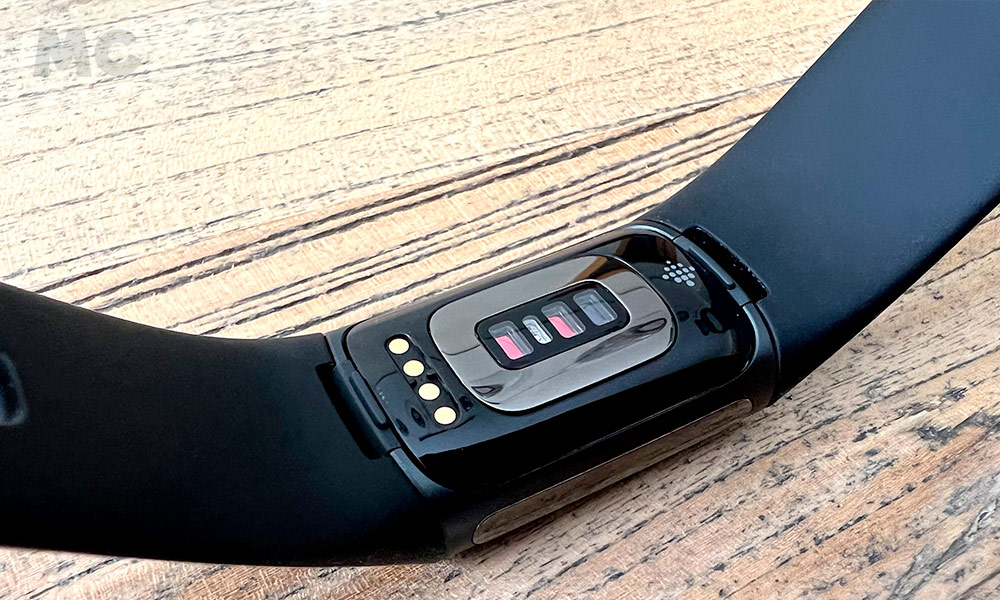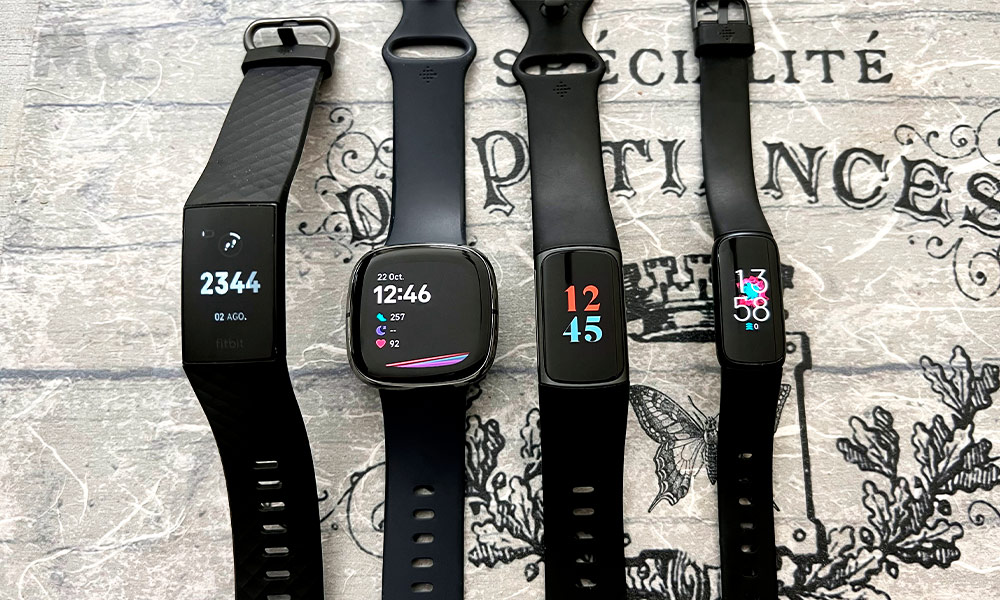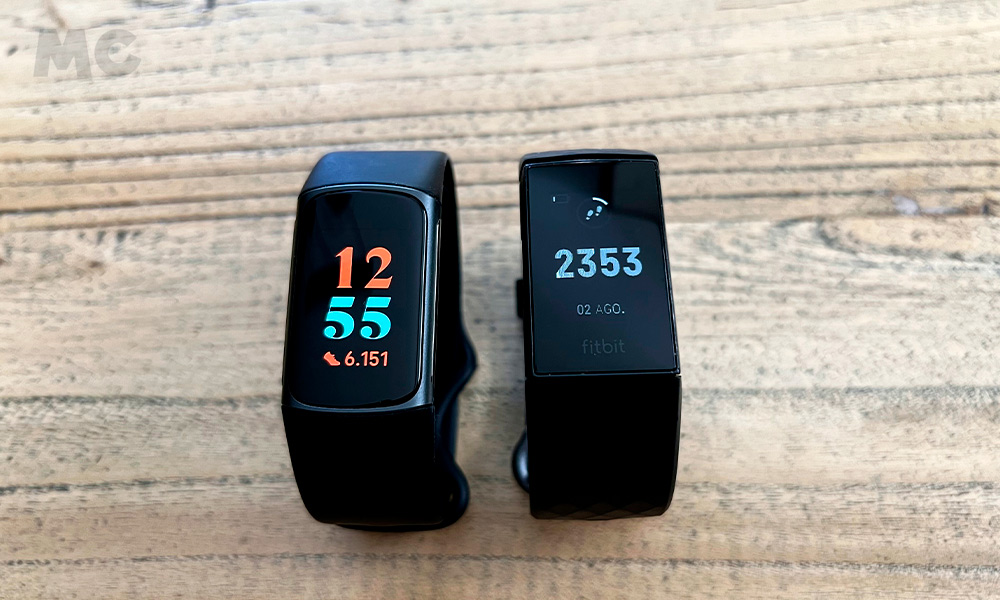
At the end of August, the pre-sale of the Fitbit Charge 5 activity bracelet was announced , which is already marketed in Spain for 175.95 euros . We are talking about the fifth generation of the Fitbit Charge that was born with the HR model (what a difference its small screen compared to the current one!) And that has gone through different versions (Charge 2, Charge 3 and Charge 4) until the Fitbit Charge 5 .
Regarding the Fitbit Charge 4 that we analyzed in May 2020, there is a very important design change, and not only because of the incorporation of the Super AMOLED color touch screen , but also because after several generations of an angular design with a rectangular screen, the Charge 5 has rounder lines and is also thinner (10% more).
As for the most visible novelty, its color screen is twice as bright as the Charge 4 in daylight and is protected by Corning Gorilla Glass 3 , which makes it more resistant. In addition, thanks to the always- on screen mode (my favorite, although you have to pay the toll on the autonomy of its battery, which suffers a significant loss) it is easier to consult the information on the screen at all times.
As you can read in the specifications below, the height of the screen is 21.93 mm and it has a width of 14.75 mm . But one thing is the size of the screen and another its actual surface. Here we find a very commented drawback in forums where the Fitbit Charge 5 is discussed.
The designers could have expanded the usable screen area at the top and bottom a few millimeters and make better use of the available space. We know that in Fitbit they pay attention to the feedback they get from their users and I am sure that in a future Charge 6 they will take this into account.
Another drawback that we also find in the design is the lack of a button, even a haptic type, on the Fitbit Charge 5. Everything we do with this activity bracelet must be done by touching the screen and moving your finger over it at four o’clock. directions (up, down, left or right) to access its different functions.
When you are still, you more or less handle these movements with your finger well, although there are times when having a button that would take you back to the previous screen would have been a good idea.
But all of this becomes more difficult when you are on the go. When you’re running, the Fitbit Charge 5 displays three metrics at once, two of which are always visible in small print at the top and bottom of the screen; specifically, they are the mileage and the time you have been running.
The center of the screen is where other metrics are shown, but only one at a time and in a larger size and in color, such as running pace, heart rate, calories burned, steps or day and time. hour.
To go from one metric to another you must touch the screen with a dry tap of your finger and move forward one by one, but it is easy to accidentally touch it and force yourself to do the entire “wheel” of screens until you reach the previous one, so a button that takes you back to the previous screen is missing.
Continuing with the design of the Fitbit Charge 5, another novelty is its two metal bands located on the sides of the screen. They are used to make use of a functionality that for the first time we can enjoy in a Fitbit activity bracelet. We are talking about the ECG , the electrocardiogram that allows evaluating the heart rate in order to detect cases of atrial fibrillation.
Although we will discuss the ECG function later, saying that to use it you have to place your fingers on the two steel plates located on the sides of the Charge 5 and remain still for 30 seconds.

To finish with the evaluation of its new design, to say that the Charge 5 is a very comfortable activity bracelet to wear not only because of its scarce 28 grams of weight , we must congratulate the designers of Fitbit for the work done in the ergonomic section .
And since ergonomics do not have to be at odds with beauty and with the possibility of customizing a device that you are going to wear for many hours on your wrist, Fitbit not only gives us a choice between a totally black Charge 5 (bracelet and case) There is also a white bracelet and a gold-colored stainless steel case, or a blue steel bracelet with a platinum-colored stainless steel case.
In addition, as in other devices of the brand, it is very easy to change the strap and choose between models with hook and loop closure, sporty or leather look, all of them in different colors.
Fitbit Charge 5 Specifications
| Screen | Super AMOLED color touch screen protected by Corning Gorilla Glass 3. Possibility of always-on mode |
| Sensors | Optical heart rate monitor. Three-axis accelerometer. Integrated GPS + GLONASS. Monitoring of oxygen saturation (SpO2). Device temperature sensor. Vibration motor. Ambient light sensor. Sensors compatible with ECG and EDA Scanner applications |
| Battery | Lithium Polymer. Up to 7 days of autonomy. Charge in two hours |
| Connectivity | Bluetooth / NFC |
| Screen size | Viewing area: 26.43mm diagonal. Display height: 21.93 mm. Display width: 14.75 mm |
| Housing materials | Aluminum, glass and resin |
| Weight | 28 grams |
| Waterproof | Up to 50 meters |
| Colors | Black / Graphite black stainless steel. Ivory white / Gold stainless steel. Steel Blue / Platinum Stainless Steel |
| Box contents | Fitbit Charge 5, Infinity strap (small and large) and charging cable |
| Price | 179.95 euros. Includes free 6-month subscription to the Fitbit Premium service (valued at 53.94 euros) |
A global vision of health
Fitbit has been working for a long time so that its devices offer a global vision of our health, and after the purchase of the company by Google this commitment has only been confirmed.
The most interesting thing about the Charge 5 is not that we can monitor our sports activities, Fitbit fulfills this section with a note and more since in the Charge 4 it integrated the GPS to play sports without having to carry the smartphone on top and continue to enjoy exact metrics. By the way, it offers a “hybrid mode” (transparent for the user) so that when you carry your mobile phone with you, take advantage of its GPS and thus save battery life on the Charge 5.
What best defines the Fitbit Charge 5 is its “total health” perspective , both physically and psychologically. That is why it includes an EDA sensor to measure electrodermal activity and determine the user’s stress level, it offers the ECG function, measures the level of oxygen in the blood, indicates our minutes in the active zone , analyzes and scores our sleep or allows us to know if our body is ready to exercise or if otherwise it is convenient for us to recover.

To talk about each of these functions that make the difference in the Fitbit Charge 5, it is best to start with the Daily Recovery Level , included for Fitbit Premium users (remember that together with the Charge 5 there are six months of free access ) and that it uses the data collected by the device (it is also available in Sense, Versa 2, Versa 3, Inspire 2 and Luxe) to assess if we are ready to exercise or if we should focus on recovery.
The data it uses to give us a score (similar to the concept used with sleep) on our level of recovery are heart rate variability while we sleep, activity performed, and recent sleep patterns . With this, it gives us a high score that indicates that our body is recovered and ready for intense exercise or a low score that shows that our body is fatigued and must rest.
Both the type of activity carried out and the need for sufficient and constant rest are data that come to mind when we talk about recovering energy. The one that is not so obvious is the variability of the heart rate, that is, the variation of the time between the beats of the heart while we sleep. Fitbit uses it because a high variability is a positive sign of readiness, while the opposite is related to an increase in stress or tension in the body, and this takes away our energy.

From left to right we have a Fitbit Charge 4, a Fitbit Sense, a Fitbit Charge 5 and a Fitbit Luxe. These last two are color screen activity wristbands, but there is a big difference in usable area in favor of the Charge 5.
Also very interesting, although it was already available in the family from Charge 4, are the Minutes in Active Zone (MZA), which use personalized heart rate zones to motivate us to perform activities that put our heart to work.
According to the World Health Organization, it is advisable to do at least 150 minutes of moderate activity a week, and the MZAs help us reach our goals since they record the time we spend doing activities that increase our heart rate.
What Fitbit does with the MZA is to multiply the minutes of activity of greater intensity by two, so we can reach our activity goals in half the time.
The Charge 5 vibrates while we exercise every time we change heart rate zones (it is an alert that can be disabled). We can reach the area fat burning , the area of cardio or peak area . Our heart rate zones will automatically adjust according to our progress, so they will help us to better understand how our body responds to different activities.

Here we can see how the design and screen have evolved from the Fitbit Charge 4 (on the right) to the Fitbit Charge 5 (on the left).
As for how our body reacts to stress, thanks to the EDA Scanner application we can obtain a stress management score . EDA responses are small electrical changes that occur in the skin due to stress or emotion. Fitbit can detect them during a mindfulness session of at least three minutes. The calmer we are, the less resolute we should have.
Again, Fitbit uses a score from 1 to 100, where a higher number means that our body is showing fewer signs of physical stress. To obtain this score, Fitbit analyzes heart rate variability during deep sleep, elevated heart rate when resting, heart rate when sleeping, or electrodermal activity measured by the EDA Scanner.
Fitbit Premium subscribers have access to a detailed breakdown of the three main metrics on which the score we’ve referenced to measure stress level is based: responsiveness, balance of effort, and sleep patterns. . Therefore, we must sleep with the Fitbit Charge 5 because it is during the night that this activity bracelet measures many of the variables that it uses for all these scores that we have mentioned.
Add that thanks to the Fitbit Premium subscription we can enjoy relaxation and meditation sessions from the Calm app . By the way, although it does not have to do directly with stress management, since I have mentioned one of the benefits of being Premium, to say that from Fitbit they have reached an agreement to be able to enjoy with this subscription more than 100 routines performed by trainers professionals, as well as the new high intensity workouts from Les Mills .

Conclusions
The Fitbit Charge 5 activity tracker represents an important evolution in the Charge family, incorporating for the first time a color screen, as well as the EKG or Daily Recovery Level functions.
Only for this and for its attractive and comfortable design, as well as for incorporating the GPS (available already from the Charge 4) and for its traditional long battery life (up to 7 days if the GPS or the screen is not used intensively always active) deserves our “Good Choice” award.
It does not reach the “Recommended Product” seal for two details that we are sure Fitbit will solve in new models of the Charge family. We refer to the fact that the usable surface of the screen could grow a few millimeters both above and below and the fact that lacking any type of button, sometimes the movement between the multiple screens to which we have access is complicated.Final assessment
ABSTRACT
The Fitbit Charge 5 activity tracker is the latest addition to the Charge family and it does so with a design change that stands out for its color screen, but also includes interesting new features such as the EKG function and the Daily Recovery Level.



